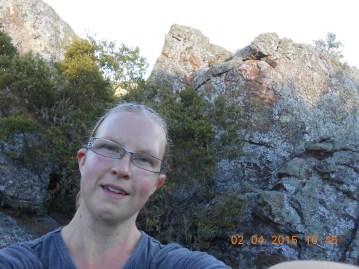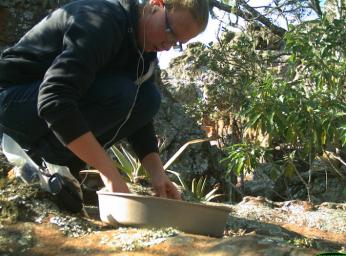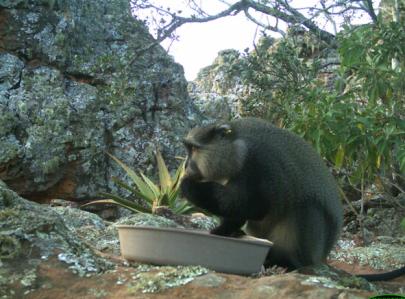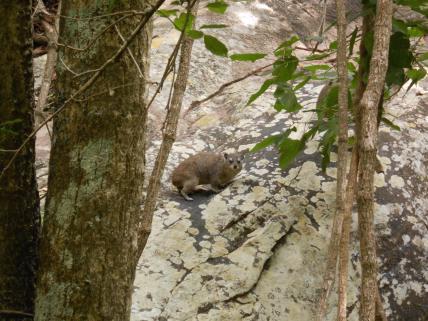One of the Primate and Predator Project's research aims is to understand the behavioural ecology of predator-prey interactions. Durham University Masters student, Emily Lake, worked with the Primate and Predator Project to explore this concept by researching dassies at Lajuma Research Centre. Here's Emily's story about her research and her experiences in the field. So my study species may have a strange name and an even stranger evolutionary history but it gets 10 out of 10 on the cuteness scale.
I'm Emily and I have just completed my fieldwork at Lajuma, working alongside the PPP. I came to South Africa to study an animal known as a hyrax. In South Africa they are called dassies and they live in rocky habitats known as koppies.

Here's a rundown of what makes these little critters so unique. Their closest genetic relative is the African elephant (don't believe me? Google it). This means that their life history (birth and death cycle) is very slow, females are pregnant for 8 months and only give birth to an average of 2 babies per year and can live her up to 12-15 years in the wild. This means that any impact on their population could be potential devastating. But here's the really strange part, their population is attacked on a daily basis by almost every type of predator that sub-Saharan Africa has to offer. Dassies are the favourite food of multiple eagle species, leopards, other small cats such as caracals and snakes just to name a few. There are also certain predators that have become specialist dassie hunters. One such predator is the leopard, and the leopards that call Lajuma and the surrounding Soutpansberg Mountains home love to eat dassies. So much so that over 40% of their diet is dassies. The Verreaux's eagle is also a lover of dassie meat and in some parts of its range dassie forms a whopping 98% of its diet. So these small, inconspicuous little mammals are under attack almost constantly. So why haven't they just gone extinct? That is one of many of the big questions I am keen to start to answer.

I arrived at Lajuma, full to the brim with enthusiasm and armed with a grand plan of experiments to investigate the anti-predation behaviour of hyrax in the area. The first of these experiments was to run a pilot study for my giving up density experiments. These types of experiments involve placing measured amounts of food in a tray with a measured amount of inedible substrate and placing those trays around the habitat of your study species and then recording how much food is consumed from each tray. I hoped this would tell me what habitat types, or even which specific features of the habitat the dassies saw as safe, or useful for evading predators. The classic example is open versus cover. If I put a tray out in the open and another tray under a shrub or rock and there is more food eaten from the tray under cover then I can assume, all other variables the same, that the dassies felt safer under cover and therefore foraged longer at that tray and ate more food.

Sadly the pilot study never happened. I put out some test trays and these were very quickly discovered by a local troop of baboons who helped themselves to the food and enjoyed playing with the trays and other equipment (all captured on camera traps). I began baiting potential study sites with various foods including peanuts, corn, rabbit pellets and chicken food all to no avail. I recorded rodents such as tree squirrels and porcupines foraging and even attracted the odd mongoose but no dassies.

I actually landed upon my final method for data collection a little bit by accident. When I began to suspect that these experiments were not going to work I decided to try and investigate the composition of the dassie colonies in the area more closely and I chose camera trapping to do it. Everywhere I, or others, had seen dassies I placed a camera trap. I also selected sites that I suspected of having dassies; for example if there was a latrine close by (dassies make latrines where the entire colony defecates as a way of marking their territory) or there was good habitat such as deep rock crevices.
In the end these camera trap images have now formed the basis of my project and I now have a new project based around these. I will be examining the activity patterns of dassies from both an ecological and social perspective to further understand the species and its anti-predator behaviour.
I learned so much about experimental designs and the ups and down of fieldwork. I now have a new found understanding for working with wild animals in such a wild environment. Despite everything not going to plan (I mean when does it? It's science!) I wouldn't change a thing about my time at Lajuma.
I couldn't have done it without the support of the team at Lajuma and the Primate and Predator Project. It's such a great set up and even though I was an independent student I helped out on the project and they reciprocated and helped me when I needed it. I will be forever grateful.






